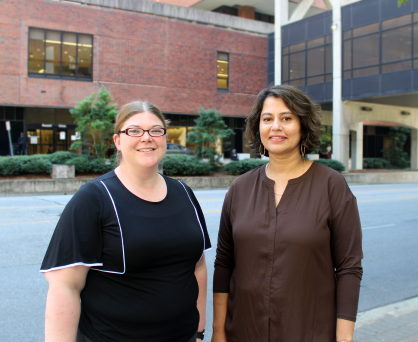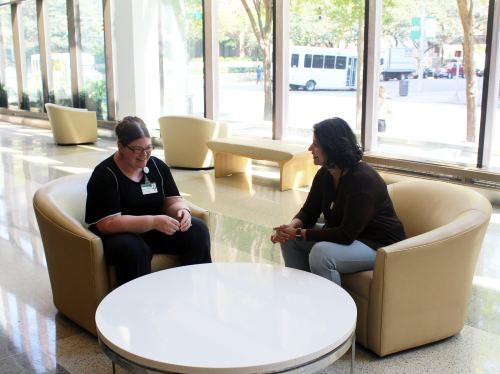by Hannah Buckelew
 Mary Kathryn (M.K.) Sewell-Loftin, Ph.D., and Mythreye Karthikeyan, Ph.D.The American Medical Association designates the month of September as Women in Medicine Month to celebrate the accomplishments and contributions of women in the field. To showcase the impactful contributions of women in the UAB Heersink School of Medicine, Mythreye Karthikeyan, Ph.D., an associate professor in the Department of Pathology’s Division of Molecular and Cellular Pathology, and Mary Kathryn (M.K.) Sewell-Loftin, Ph.D., an assistant professor in the Department of Biomedical Engineering (BME), answer a series of questions about their recent collaboration on the study, “Emerging perspectives on growth factor metabolic relationships in the ovarian cancer ascites environment.”
Mary Kathryn (M.K.) Sewell-Loftin, Ph.D., and Mythreye Karthikeyan, Ph.D.The American Medical Association designates the month of September as Women in Medicine Month to celebrate the accomplishments and contributions of women in the field. To showcase the impactful contributions of women in the UAB Heersink School of Medicine, Mythreye Karthikeyan, Ph.D., an associate professor in the Department of Pathology’s Division of Molecular and Cellular Pathology, and Mary Kathryn (M.K.) Sewell-Loftin, Ph.D., an assistant professor in the Department of Biomedical Engineering (BME), answer a series of questions about their recent collaboration on the study, “Emerging perspectives on growth factor metabolic relationships in the ovarian cancer ascites environment.”
What is your study's research focus?
Dr. Karthikeyan: “The Mythreye Lab has been focusing on mechanisms of metastasis as they pertain to gynecological cancers, any cancer that starts in a woman’s reproductive organs. Our emphasis is on how cells respond and adapt to environmental changes related to growth factor imbalance, stress responses and extracellular matrix changes. We are using a combination of human-derived and animal models along with multi- omics strategies to discover new mechanisms of metastasis and develop therapeutic avenues.”
Dr. Sewell-Loftin: “The Sewell-Loftin Lab is focusing on understanding how biomechanical forces in and around tumors affect cell growth, angiogenesis, and response to chemotherapies. We have specialized microfluidic devices, or microtissue models, where we can tease out the effects of matrix stiffness/composition and changes in matrix structure or tension caused by different cell types in the tumor microenvironment. In this specific study, there is new evidence emerging that mechanobiology and metabolism may be linked in tumor growth. The ovarian cancer ascites environment is dramatically different from a mechanical standpoint compared to the same regions in patients without tumors.”
How long have you worked in this area and what initially sparked your interest?
Dr. Karthikeyan: “I started my work in the cancer biology field as a postdoctoral fellow in 2006. My Ph.D. training prior to that was in mechanisms of chromosome segregation and chromosome loss, a phenomenon very relevant to cancer. My transition to cancer biology was sparked by my post-Ph.D. desire to focus on a disease where I could bring my doctoral training to action. Subsequently, some key mentoring and collaborative experiences during my postdoctoral days revealed clear gaps in our understanding of ovarian cancers, which was, and still is, behind other cancers in targeted therapy options for patients, primarily due to a lack of understanding of the disease progression. These gaps presented unique research opportunities that hopefully can benefit patients as well.”
Dr. Sewell-Loftin: “I’ve been studying the cancer mechanical microenvironment since 2014. I first started working on ovarian cancer in the fall of 2020 through a collaboration with Dr. Joel Berry in the BME department. I met Dr. Karthikeyan in late 2020 during a Zoom ‘roundtable’ discussion on ongoing ovarian cancer research here at UAB. We started exchanging emails and realized there were some great potential questions we could collaborate on.
How have your labs been collaborating in this study?
Dr. Karthikeyan: “Our labs interacted initially through an ovarian cancer research forum in the early days of the pandemic and soon after my move to UAB. Clear areas of synergy were identified, particularly mine and Dr. Sewell-Loftin’s, as both of us were interested in interactions between different cell types found in tumors. The review that we wrote together is a first step and a culmination of shared discussions on factors that influence ovarian cancer metastasis. We anticipate these studies to lead to manuscripts and grants in the very near future.”
Dr. Sewell-Loftin: “We specifically collaborate on tumor-endothelial interactions, influences of angiogenic changes in the host, synergizing our findings in vitro and in vivo with mechanobiology, linking matrix composition and organizational changes to change in cell behaviors, and exchanging reagents and ideas.”
Does your research focus heavily on gynecological cancers?
Dr. Karthikeyan: “While my lab has historically focused on mechanisms in a cancer agnostic manner, in the past six years, I have felt justified in focusing all our efforts on gynecological cancers. I think this has allowed us to improve the models used, understand the aspects that are unique to this disease and work closely with clinicians in a more effective manner.”
Dr. Sewell-Loftin: “I’d say my work is split pretty evenly between investigating the tumor vasculature, breast cancer, and ovarian cancer. A lot of the tools we design are cancer agnostic, so I’ve been able to do things like launch this ovarian cancer collaboration with Dr. Karthikeyan and learn a lot in the process.”
What are the overall goals of your study?
Dr. Karthikeyan: “The broad goals of our collaboration are to discover new mechanisms of host- tumor interactions at the intersection of vasculature and matrix biology and to define how these interactions coordinate disease progression.”
Dr. Sewell-Loftin: “Ditto.”
What does it mean to you to be a woman in medicine?
Dr. Karthikeyan: “Female representation when combined with mentorship can be an extremely powerful force in encouraging and retaining women in science as they progress through their careers. While I have been fortunate in having extremely supportive male mentors and advocates, the role a handful of women mentors, colleagues and advocates have played in shaping my career cannot be overstated. I have been able to navigate specific challenges that a female scientist may face as a result of the support I have received from other women scientists. There is no doubt that women face unique challenges at the workplace in managing work-life balances and in self-advocating. Thus, being able to see and learn from other women is extremely helpful.”
Dr. Sewell-Loftin: “I was a post-doc before I had a female mentor. I didn’t work in her lab, but she was a source of support and guidance as I figured out my path to open my own lab. The gender gap in Biomedical Engineering undergraduate programs has largely evened out, but there are still fewer female engineering graduate students, faculty, and even fewer women in senior/administrative positions in my field. I feel lucky to be in a place now where I have so many other colleagues who are women in the O’Neal Comprehensive Cancer Center and at UAB at large. I am now trying to do my part in offering mentorship and support to the young women and underrepresented student groups in my classes and department. I know what a difference it made in my own life.”